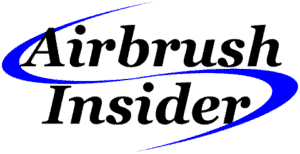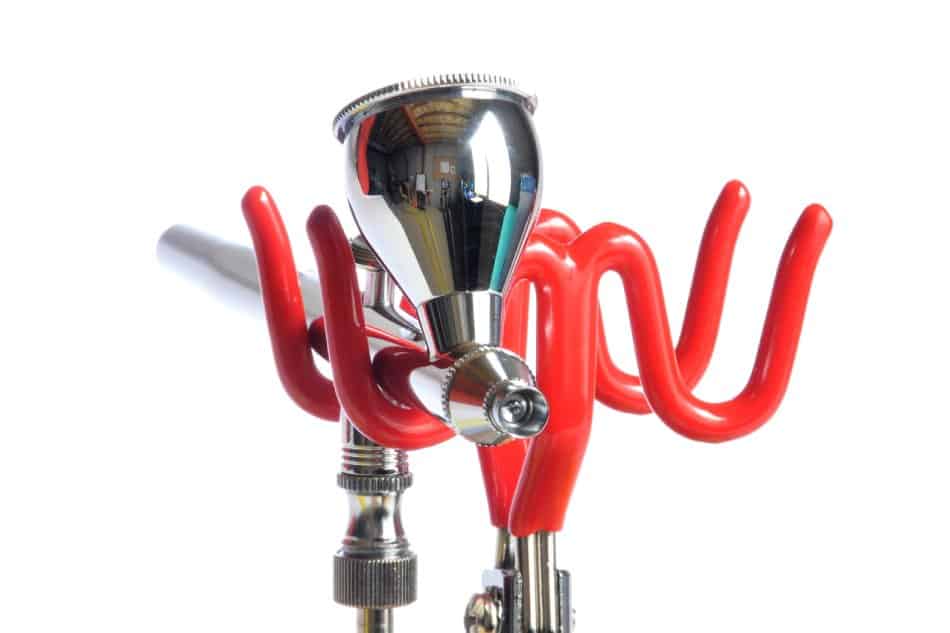Airbrush tip dry is likely one of the most annoying parts of using an airbrush. But many, along with myself wonder if there is a way to prevent it (stop it) from occurring???
So I did some in depth research and came to the following conclusion,
Now first of all, tip dry is a common occurrence when working with water based paints. Solvent based paints don’t commonly deal with tip dry as often…
Tip dry: occurs as the flow of air (Used to atomize the paint) exiting the airbrush nozzle begins to dry paint that gets left behind on the airbrush needle tip. This dry paint on the tip of the airbrush needle begins to build up as you airbrush until it gets so thick that it either begins to semi-clog the airbrush nozzle (making the airbrush feel unresponsive), or is blown off onto your painting creating what is known as splatter…
Either way, both of these results can become a problem especially if it is occurring often…
Now, you can’t completely stop tip dry, but there are ways to minimize it.
Methods To Minimize Tip Dry
After scouring the internet for Ideas to prevent, or at least reduce tip dry, I have come up with a few options that I believe to be the best in terms of minimizing tip dry when using an airbrush.
I personally found a reduction in tip dry by using a few of the methods listed below, and I believe you will as well.
Use Paint Retarder Or Flow Improver
By adding Paint retarder or flow improver to your paint you will see an increase in the amount of time it takes for the paint to dry, which will result in less tip dry as you airbrush.
However, by slowing down the dry time of your paint, it will impact the amount of time it takes for the paint to dry on your work. Meaning you’ll have to wait for a short period of time between coats.
But as long as you don’t over do it, It shouldn’t increase the dry time so much that your waiting a significant amount of time between coats.
A few Paint Retarder & Flow Improver options are listed below. Its ideal to go with an option that is made by the same manufacturer that makes the paint you use.
- Liquitex Fluid Retarder (found on amazon)
- Vallejo Acrylic Paint Retarder (found on amazon)
- Createx Airbrush Paint Retarder (found on amazon)
- Vallejo Airbrush Flow Improver (found on amazon)
- Liquitex Professional Flow Aid (found on amazon)
Or You Could Put A Few Drops Of Glycerin In Your Reducer
Glycerin is said to be a natural flow aid, and lubricant. Many of the homemade airbrush thinner recipes call for glycerin. I actually wrote an article on a few of my favorite homemade airbrush paint thinner recipes if you’d like to check them out. A majority of them call for a few drops of glycerin.
Use Needle Lube
By applying a small amount of needle lube on the tip of your needle it essentially covers up any small imperfections on the needle tip that will allow the paint to grip the tip and hold on.
By using needle lube you are essentially applying a very thin film of lube that will prevent, or at least minimize paint buildup on the tip of your needle.
One of the most commonly used needle lubricants (Said to be the best) is,
- Badger Regdab Needle Juice (found on amazon)
To apply it, simply remove the needle from the airbrush and dip the tip of your needle in the “Badger Regdab Needle Juice”, let it sit on the needle tip for 30 seconds or so, then wipe it off gently. Allows for upwards of a few hours of working time before it needs to be reapplied.
Polish The Tip Of Your Needle
Now, this method is not recommended for beginners as it is quite easy to cause damage to the needle. But by polishing the tip of your needle you are essentially removing any microscopic divots / Imperfections that make it easier for the paint to build up on the tip of your needle.
Plus a polished needle tip not only reduces tip dry, it also improves the spray pattern, as well allows for finer lines to be achieved.
This Idea is from Airbrushdoc. Below is a video of him demonstrating the process. But remember this is not Ideal for beginners, and be sure to wear the proper safety equipment when using this method…
Over Reduce Your Paint & Turn Down The Air Pressure
Tip dry commonly occurs more frequently when the paint in your airbrush is on the thicker side in terms of consistency. But by simply over thinning your paint you can reduce the frequency to which tip dry occurs.
But keep in mind, the thinner you go with your paint, the more coats your gonna need to apply in order to achieve full color vibrancy.
As well, by over reducing your paint. Its likely you’ll be able to turn down the air pressure which will better help prolong the time between needle tip cleanings.
Side note: White paint is commonly much thicker then the majority of other colors, doesn’t matter the brand of paint (At least when discussing acrylic airbrush paint). So by over reducing your white paint (that is assuming you use white often) you can reduce tip dry, as well as eliminate clogs.
Simply put, the viscosity of your paint can play a big factor on how often tip dry occurs. For a complete walk through on airbrush paint reduction do checkout my latest guide.
But by simply adding a little more reducer to your paint, you can minimize how often tip dry occurs.
How to Clean Off Tip Dry
Given that we can’t completely stop airbrush tip dry, there are going to be times you’ll have to clean off the needle tip. Below are a few tips to help you remove tip dry.
Note: you will likely need to remove the airbrush needle tip guard on the tip of your airbrush in order to get at the needle tip so you can clean it. Most airbrush full time with the needle tip guard off to make for easy access to the needle tip as tip dry occurs. But there is a higher likelihood of damaging the needle tip when working like this.
Now, for the most part I personally just use my fingers to remove tip dry as it occurs. However, below are a few of the other methods I’ve used that work well.
Use A Sponge
Probably my favorite method for cleaning off tip dry is by using a small sponge that I can hold in my hand as I airbrush.
It’s simple, You’ll lightly moisten the sponge with a small amount of one of the following:
- Isopropyl Alcohol
- Airbrush Cleaner
- Homemade Airbrush Thinner / Cleaner (Link to my post on making your own thinner / cleaner)
Even water or commonly found acrylic airbrush thinner works.
Then when it comes time to clean the dry paint off the tip of the needle, (With the needle tip guard off) you’ll simply poke the tip of the needle into the sponge. Then go back to airbrushing. Its super easy, and reduces the likelihood of damaging your needle tip.
Of course you’ve got to always pay attention to the tip of the needle as its sharp and can poke you. But for the most part I’ve found this method for cleaning off tip dry to be the most effective, and quickest out of all the methods I’ve tried…
Use An Old Toothbrush
Another great method for cleaning off tip dry is by using an old toothbrush (with soft bristles).
It simple,
You’ll moisten the toothbrush bristles using one of the following,
- Isopropyl Alcohol
- Airbrush cleaner
- Homemade Airbrush cleaner
- Water…….
Then when it comes time you need to clean off tip dry, lightly brush the tip of the needle (with the needle tip guard off).
You need to be very careful using this method, as it can be easy for the needle tip to snag, or bump the toothbrush head.
Use A Q-tip
Another method commonly used is to simply wipe around the needle tip using a Q-tip.
You’ll begin by moistening the Q-tip using one of the following,
- Isopropyl Alcohol
- Airbrush Cleaner
- Homemade Airbrush Cleaner
- Water
- ETC…
Then simply wipe around the needle tip using the moistened Q-tip. Simple!
Now, though this method works well, I find it to be quite time consuming in the grand scheme of things. As you’ve gotta take the time to carefully wipe around the needle rather than simply dip it into a sponge as done in the first method above.
But it’s another option worth considering…
Conclusion
In the end, tip dry isn’t something that can be completely avoided. However, for most out there, there are methods to reduce the frequency to which it occurs (As listed above).
Another quick tip for those of you who made it this far, (Now this does apply to only those using a double action airbrush, but given that the majority use a double action airbrush odds are this will apply to you):
Simply maintaining a consistent airflow as you use your airbrush will help in reducing tip dry. For instance, you want to avoid using your airbrush in a way that mimics a can of spray paint.
So instead of pulling back on the airbrush trigger, then pushing down for paint (giving you an instant pulse of paint). You’ll want to do the following in numerical order any time you go to spray a (line, dot…etc) of paint:
- Press down for air
- Pull back for paint
- Push forward to stop paint flow
- Let up to stop air flow.
By maintaining a flow of air over the needle (both before and after you lay down some paint), you’ll minimize the amount of paint that is allowed to dry on the tip. So simply start with air flow, and end with air flow anytime you apply paint.
Anyway, I hope you were able to find some value here! If you have any further questions regarding the airbrush do be sure to take a look around the website. Airbrush Insider is dedicated to helping all in the airbrush community!
This is Colt signing off!
Check Out Some Of My Favorite Airbrush Equipment:

